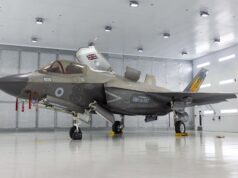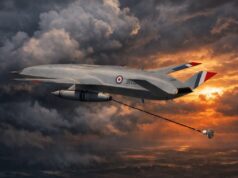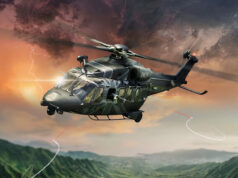The Bell V-280 Valor successfully achieved its namesake optimal cruise speed of 280 knots, say Bell.
Keith Flail, vice president of Advanced Vertical Lift Systems at Bell, said:
“It is a remarkable achievement to hit this airspeed for the V-280 Valor in just over a year of flight testing. Beyond the exemplary speed and agility of this aircraft, this significant milestone is yet another proof point that the V-280 is mature technology, and the future is now for FVL capability set 3.”
The V-280 is, say the builders, purpose-built to conduct long range assault at twice the speed and range of existing medium lift helicopters.

Ryan Ehinger, V-280 programme manager at Bell, said in a release:
“Cruising at twice the speed of legacy helicopters, with double the range, really changes the way the U.S. military can enable multi-domain operations. By eliminating forward refueling points alone, leaders can focus on operational goals while minimising logistical burdens.”

As the programme moves into 2019, V-280 flight testing will continue to prove out Bell’s key performance parameters and reduce FVL risk in the U.S. Army led Joint Multi-Role Technology Demonstrator (JMR-TD) programme.
The next stages will expand the performance envelope exploring further low-speed agility maneuvers, angles of bank and autonomous flight.
- Forward flight at 280 knots true airspeed
- Over 85 hours of flight and more than 180 rotor turn hours
- In-flight transitions between cruise mode and vertical takeoff and landing
- 45-degree banked turns at 200 knots indicated airspeed
- 4500 feet per minute rate of climb and sustained flight at 11,500 feet altitude
- Single flight ferry of over 370 miles
- Demonstrated low and high-speed agility with fly-by-wire controls














I can’t see these taking over from helicopters! Apart from specialised use like special forces, medi vac ect. Does the SAS fly two ospreys for in the uk?
No, a newspaper reported that they did, but in reality the SAS were just on a training op with a US unit of Ospreys at Lakenheath
While the additional speed and range are obviously great benefits, I can’t help but feel that VTOL aircraft like this are too big and vulnerable for tactical transports. That big wing in particular seems very vulnerable when in hover mode.
It has the same footprint as the Blackhawk
I wonder which would be best on our carriers for hosting a Crowsnest system, (a) helicopter, (b) Valor, (c) drone?…
Personally anything other than a Merlin, it’s a mad waste, using the most expensive and by far the best ASW rotor in the world to cart around crowsnest, I sometimes don’t get our military planners. If they needed some one the merlins as crowsnest trucks why pay to upgrade them all to merlin 2 specs ?
When carting around the crowsnest kit the Merlin can still swing roles to ASW. So, for example, it might spot a periscope and then go stright for the localise-and-kill allowing a 2nd Merlin (whirling and burning on a carrier spot) to take up the AEW.
Think of it as a pre-scrambled ASW, ASuW and SAR copter that does AEW whilst it waits 🙂
I hear you on the swing-role aspect, and keeping it all Merlin avoids another line of spares, maintenance specialities etc on the carriers but if the Valor has similar service ceiling to the Osprey, I.e. about 10,000 feet higher than Merlin I think, then is that extra height and hence surveillance reach compelling enough to outweighs the benefits of keeping it all Merlin?
So AEW Merlin will be able to carry the Crowsnest module and Stingrays too? Spot a periscope leave the AEW station, protecting the task group, transit to the contact, localise and identify the target, shoot its torpedo, while another Crowsnest equipped Merlin which happens to be turning and burning is ready to take the AEW station? The MoD only has 10 modules and what about the gap in coverage of AEW? And what about the ASW from the escorts and any stationed on RFA? I know Crowsnest is all about reroling, but this dual capability in that Merlin could do both AEW and ASW all at the same time has gone by me.
Not sure how that will work, AEW and ASW are to completely different sets of activity and I’ve never seen anywhere that the merlin carting the AEW kit and crew will be able to do ASW work without the AEW kit and crew being changed over.
I can’t see how a task group would suddenly redeployment it’s AEW asset to adhoc ASW work. If we did operate in that way any clever opponent would exploit it.
I’m not sure it will be possible for a merlin to even do both at the same time, I’m not sure you would be able to cram in the ASW guys and girls in the same cab as your AEW crew, may be a bit to snug. Or will we have our merlins crewed by very stresssed people who become expert in both ASW and AEW all at the same time.
Sorry, but that does not seem like a realistic scenario. AEWS systems need altitude to maintain surveillance. For such an aircraft to divert itself to attack a submarine would mean that it is straying from its primary task, and would leave the fleet blind to any incoming aircraft or missile attack
IMHO, if a periscope is spotted, another aircraft would be vectored in to by the AEWS to investigate, and/or take action. They are basically the “eye in the sky” and a C3 aircraft.
The modularity of the Crowsnest system means that the modules can be transferred to other Merlins. If one is down, then another aircraft can be substituted to carry the modules and provide continuous AEWS coverage.
One to keep an eye on is the V-280’s stablemate, the VUAS V-247. Being vtol, it could operate from the carriers and a pair of them can provide 24hr surveillance, either asw, aew or persistent observation of ground targets. Hopefully the USMC will continue their work towards filling this capability. http://bellflight.com/military/bell-v-247
When I suggested a drone as an alternative, I was thinking of something like the Fire Scout, but this looks far better ??
V247 represents an excellent opportunity to propel our QE class carriers to the very top of global carrier capability. 36 F35 B with four of these providing AWACs is capability beyond what even the Nimitz class will be deploying this side of 2040.
Does it wing’s fold?
The current prototype has a fixed wing for testing, the next version will have a rotating wing like the Osprey. The Marines want to use this much like a Reaper for reconnaissance and close air support. Part of the requirement is that it can be used from any Marine Corps ship, but also from the helipad of a destroyer/cruiser, hence the folding wing etc. The aircraft is about 2/3 the size of a Valor. The Valor has approximately the same fuselage size as a Blackhawk, however, the width of the combined rotor disc is slightly wider.
The V280 doesn’t, the V247 does.
https://www.youtube.com/watch?v=rxlVo08kFZU
I hope that just like the lightweight fighter program from the 70s which gave birth to the F16 and F18, that the US finds a home for both of the contenders for the Future Vertical Lift (FVL) program.
The other being Boeing’s entry:
https://twitter.com/Sikorsky/status/1090978208206540800
They likely will. I can see the V-280 as something more for rapid response units like the 82nd and 101st Airborne along with the Marine MEUs, due to the range and speed they offer.
I think the Defiant is more suited to the needs of the regular army due to likely easier maintenance (much fewer moving parts) and because of the smaller profile when landing.
I love the Defiant it is a somewhat similar concept to an amazing kit model I had as a kid supposedly based on a German 2nd WW design that never came to fruition. Well not for 70 years anyway. Indeed as so many aspects of the design already long existed separately, I do wonder why no similar design ever got half way to fruition before now as far as I know.
One design did the AH-56 Cheyenne gunship was a pusher helicopter that was flying, before it was canceled in favor of the less ambitious Apache and for upgrades to the Cobra.
no point thinking we’ll get a couple, if we didn’t go for a couple of ospreys, these are a non starter
I word rather have these than Ospreys they are a generation ahead potentially more flexible and one would hope will be cheaper to operate, though time will tell on that one.
I’d like to see something like this as COD/AEW/air assault troop transport on our carriers. Far more capable than Helis.
What interests me is what happens during an engine failure. The drag created by the feathered prop must be substantial leading to a violent yaw. Anyone know the details?
A driveshaft runs through the straight wing, allowing both prop rotors to be driven by a single engine in the event of engine loss.
Makes sense, Thanks Tim! So its all or nothing. Can one engine be run in Hotel mode or is there a dedicated APU?
The manufacturer claims it can recover on just one engine in helicopter mode, they did not state if this was at all up weight or not. It will be one of the US Army’s pre-requisites, much like the Osprey.
An interesting piece of kit.
Curious as to why Bell pulled out of the Augusta Westland 609 program just to develop this very similar military only product in isolation.
It looks like the 609 has it fairly well beaten on specs.